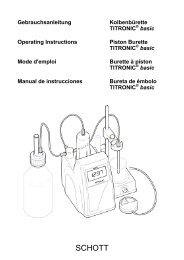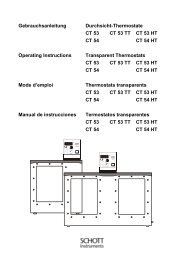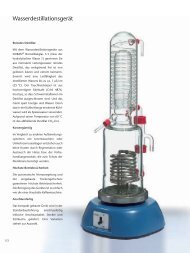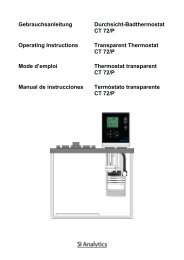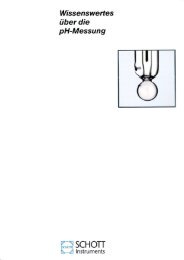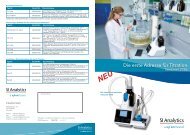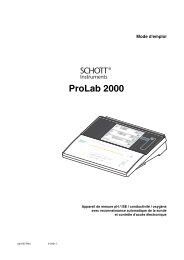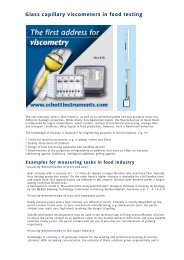English-pdf - SI Analytics
English-pdf - SI Analytics
English-pdf - SI Analytics
Create successful ePaper yourself
Turn your PDF publications into a flip-book with our unique Google optimized e-Paper software.
222<br />
Innovative electrochemistry, innovative viscometry –<br />
from the very beginning.<br />
Thorough quality control checking is an essential element from start to finish. The zero point<br />
and response time of every electrode is checked – as shown here with a batch of BlueLine<br />
laboratory electrodes.<br />
The success story of electrochemical<br />
measurement began more than<br />
75 years ago with the development of<br />
the glass electrode at SCHOTT.<br />
It is hard to imagine – but in 1936<br />
SCHOTT revolutionized the field of<br />
che mical measurements with a glass<br />
electrode that looks more like a glass<br />
bulb. Glass electrodes made from the<br />
newly created, electrically conductive<br />
The new measurement method had to be<br />
explained:in 1938 we published our first<br />
instructions for elec-trochemical pH measurement<br />
and potentiometric titration.<br />
pH glass were developed at the Jenaer<br />
Glaswerk SCHOTT & Gen., making<br />
it possible to achieve “sufficient accuracy”<br />
for pH measurements “with conventional<br />
pointer-type galvanometers”.<br />
In 1938 our first brochure descri bed<br />
how this was achieved. The development<br />
was based on the experience<br />
which we had gained from close cooperation<br />
with pioneer users in the<br />
industry.<br />
Glass know-how was also the idea<br />
behind another measurement process<br />
that we pioneered in 1940: capillary<br />
visco metry. With precisely calibrated<br />
glass capillaries it was possible to<br />
determine the viscosity of Newtonian<br />
liquids more accurately than with any<br />
other method known at that time. You<br />
needed to measure the time required<br />
for a liquid sample to flow through a<br />
calibra ted capillary with a defined<br />
constant. Then the required time was<br />
measured manually with a stop-watch.<br />
Today that works more comfortable<br />
and more precisely.<br />
The success story of our meters began<br />
in the 1970s of the last century.<br />
Even today glass blowing talent is still<br />
indispensable.<br />
In addition to our pH electrodes and<br />
viscometers, advances in the field of<br />
microelectronics in the seventies<br />
paved the way for the development of<br />
our first instruments.<br />
To enable us to react faster and more<br />
flexible to our customer needs<br />
SCHOTT Geräte GmbH was established<br />
in 1973 as a separate company.<br />
Our newly developed instruments –<br />
such as laboratory meters, pH meters<br />
and the automatic viscosity measurement<br />
system AVS® – caused a sensation<br />
and rapid ly conquered their<br />
respective markets.<br />
Our first microprocessor-controlled<br />
piston burette and our titration systems<br />
were a small sensation in the<br />
industry. Our lower cost, portable,<br />
pocket-size pH meters and conductivity<br />
meters were an instant success. In<br />
1988, SCHOTT Geräte presented the<br />
first PC-controlled titration system.<br />
Our innovative AVS® products have<br />
also made life much easier for our customers<br />
who need to measure viscosity.<br />
Examples include the practical ViscoClock,<br />
the AVS®Pro II, an apparatus<br />
for automatic viscosity measurements
Our buffer solutions are hermetically sealed in<br />
double-pointed ampoules and sterilized with<br />
superheated steam. You can rest assured that<br />
you will always have a reliable buffer solution<br />
on hand for calibration.<br />
that is top-of-the-line worldwide, or<br />
the modular measurement systems<br />
AVS® 370 and AVS® 470. We also have<br />
set new standards for top-of-the-line<br />
equipment with the TitroLine®<br />
6000/7000 titrator, the TITRONIC®<br />
500 piston burette and the new KF<br />
titrators TitroLine® 7500 KF and<br />
TitrLine® 7500 KF trace.<br />
From SCHOTT to Xylem<br />
In 2003 SCHOTT Geräte GmbH<br />
became SCHOTT® Instruments GmbH<br />
and part of Nova <strong>Analytics</strong>. The location<br />
including development and the<br />
production remained in Mainz. In<br />
2009 SCHOTT® Instruments became<br />
<strong>SI</strong> <strong>Analytics</strong>. In 2010 Nova <strong>Analytics</strong><br />
was acquired by ITT and was inte-<br />
A customer satisfaction<br />
center. In our application<br />
laboratory, for example,<br />
new methods can be<br />
developed for our<br />
customers or the<br />
suitability of existing<br />
methods for new<br />
applications can be<br />
tested.<br />
With the processed calibration, the<br />
viscometers are provided with an ID number<br />
and a certificate documenting the specific<br />
characteristics.<br />
grated into the company as ITT <strong>Analytics</strong>.<br />
The fluidtechnology part of ITT to<br />
which <strong>SI</strong> <strong>Analytics</strong> belonged became<br />
the stand-alone company Xylem Inc.<br />
Xylem is headquerted in White Plains,<br />
N.Y., USA and is a leading global water<br />
technology provider, enabling customers<br />
to transport, treat, test and efficiently<br />
use water in public utility, residential<br />
and commercial building<br />
services, industrial and agricultural<br />
settings. The company does business<br />
in more than 150 countries through a<br />
number of market-leading product<br />
brands with 2010 annual revenues of<br />
$3.2 billion and 12,000 employees<br />
worldwide.<br />
Everything O.K. A batch of TitroLine®<br />
interchangable units after volume<br />
inspection.<br />
More than 75 years of research and de velopment<br />
and a longstanding tradition<br />
The list of our innovations is long: today<br />
our electrodes are smaller, more precise,<br />
faster and more stable; our equipment<br />
offers higher performance. Over the years<br />
the electrochemical measurement methods<br />
and the viscometry that we initiated<br />
have established themselves as problemfree<br />
and reliable methods throughout the<br />
world, and they have become indispensable<br />
for an incredibly varied range of<br />
applications. Nevertheless, since our pioneering<br />
days, one thing has invariably<br />
remained the same – our tradition of working<br />
very closely together with those who<br />
use our products in order to create something<br />
new.<br />
223
224<br />
A brief excerpt from our<br />
company’s history<br />
Since 1936 – consistently new products<br />
from research and development<br />
1936 Development and production of pH glass electrodes at Jenaer<br />
Glaswerk SCHOTT & Gen. in Jena.<br />
1940 Beginning of viscometer production using capillaries that were<br />
manufactured in ac cordance with the calibrated precision glass<br />
method that SCHOTT had developed.<br />
1952 Development and production of the first gel-filled, low-maintenance<br />
reference electrodes.<br />
1962 The unique platinum diaphragm makes substantially faster response<br />
times possible, among other things.<br />
1964 Double electrolyte system for reference electrodes.<br />
1970 Introduction of semiconductor preamplifiers for pH measurement<br />
technology.<br />
1972 Buffer solutions in double-pointed ampules sterilized with<br />
superheated steam guarantee reliable calibration – even after<br />
several years in storage.<br />
– S6 and S7 plug system from SCHOTT, copied time and again.<br />
1973 SCHOTT Geräte GmbH established as an independant company.<br />
– Beginning of viscometer calibration using PTB tested reference<br />
measurement standards. (German Physical Technical Institute).<br />
1974 Development and production of electronic laboratory pH meters.<br />
1975 Market launch of the first automatic viscosity measurement apparatus<br />
for aggressive and corrosive solvents (AVS/G and AVS/PA).<br />
1977 Development and production of portable electronic pH meters.<br />
1978 The first titration control unit TR 155 and the T 100 piston burette<br />
with interchange unit.<br />
1982 The first microprocessor-controlled viscosity measurement<br />
apparatus (AVS® 300).<br />
1983 Development of the new Type S pH glass for hot alkaline solutions<br />
with extraordinarily high reliability and useful life, and Type H pH<br />
glass, robust and minimal alkali error.<br />
View over Mainz with premises of<br />
<strong>SI</strong> <strong>Analytics</strong>/SCHOTT AG<br />
Source of image: SCHOTT AG<br />
1984 Combination measurement and reference pH electrode with<br />
integrated Pt 1000 as temperature sensor.<br />
– SCHOTT Geräte presents the first thermal scanning method for<br />
viscosity measurment.<br />
– The first stand-alone viscosity measurement apparatus with<br />
integrated computing function (AVS® 400 and AVS® 440) are<br />
introduced to the market.<br />
– Compact T 80/T 90 piston burettes and simple control unit TR 85.<br />
1988 Presented the first PC-controlled titration system TPC 2000 at the<br />
Achema 1988.<br />
1989 With the AVS® 500, the tradition of successful automatic samplers<br />
for determination of the viscosity of aggressive polymer solutions<br />
was continued.<br />
1990 REFERID® electrodes with polymer electrolyte, low- maintenance.<br />
1991 Low-impedance Type L pH glass for low temperatures and ultrapure<br />
water.<br />
– Automatic sampler TW 280.<br />
1992 TT electrodes, capable of withstanding up to – 60 °C.<br />
– T 200 and T 110 piston burettes and universal titration control unit<br />
TC 1200.<br />
1993 Combination pH electrodes with temperature sensor and plastic<br />
shaft.<br />
1994 Compact TitroLine® alpha titrator.<br />
1995 <strong>SI</strong>LAMID®, stable reference system.<br />
– First Windows titration software TitriSoft 1.0 (WIN 3.1).<br />
1996 New SMEK shielded 6-pin plug system.
1997 New BlueLine range of laboratory electrodes and VP<br />
plug system.<br />
– Electrodes with certified pressure and temperature range.<br />
– Market launch of the Visco-Clock for capillary viscosity<br />
measurement.<br />
1998 Development of TitriSoft 2.0 software (as of WIN 95).<br />
1999 Range of industrial electrodes up to 10 bar and<br />
135 °C, SMEK plug system in IP 68 version.<br />
– New Type A pH glass, rapid reaction in drinking water.<br />
– Market launch of the fully automatic AVS®Pro viscosity<br />
measurement system for high sample throughput.<br />
2000 Introduction of a completely new series of compact,<br />
simple piston burettes and titrators: TITRONIC® basic,<br />
TITRONIC® universal and TitroLine® easy.<br />
– Introduction of the Karl Fischer titration system<br />
TitroLine® KF.<br />
2001 Development and production of SteamLine process<br />
electrodes for CIP and <strong>SI</strong>P applications in the<br />
pharmaceutical, food and chemical sectors.<br />
2002 Sales launch of newly developed “plus” product line:<br />
TitroLine® alpha plus, T 110 plus.<br />
– Introduction of TW alpha plus sample changer.<br />
– Market launch of TitriSoft 2.5 software.<br />
2003 The compact and highly flexible AVS® 370 viscosity<br />
measurement system is presented to the market.<br />
– Change of company name to SCHOTT® Instruments GmbH,<br />
Mainz, integration into the internationally active Nova<br />
<strong>Analytics</strong> Group.<br />
2004 Amalgamation and further development of the<br />
laboratory electrode product range for the most<br />
exacting requirements in the “ScienceLine” product line.<br />
– The new generation of automatic viscosity<br />
measurement systems is rounded off with the AVS® 470.<br />
2005 The Lab meters family is introduced:<br />
A wireless sensor recognition guarantees the<br />
optimum communication between electrode and<br />
meter.<br />
2006 Introduction of the ProLab family of instruments:<br />
Multi-functional measuring instruments with<br />
integrated user recognition guarantee utmost<br />
flexibility and reliability of measurement.<br />
2007 ProLab 3000 and 4000 high-end laboratory<br />
instruments signify the cutting-edge standard for pH/<br />
ionic and conductivity measuring and for the first time<br />
combine highest measuring quality with functionality,<br />
also providing a user-friendly navigation comparable<br />
to a Windows PC.<br />
– The new Karl Fischer titrator, TitroLine® KF trace from<br />
SCHOTT® Instruments, also offers a coulometric<br />
technique for determining even smallest water<br />
content.<br />
2008 The new IoLine electrodes with their patented iodine/<br />
iodid three-chambers reference system represent the<br />
perfect solution for accomplishing the ultimate<br />
challenging measuring tasks in i.e. pharmacy,<br />
biotechnology and food industry.<br />
2009 SCHOTT® Instruments GmbH becomes<br />
<strong>SI</strong> <strong>Analytics</strong> GmbH.<br />
2010 <strong>SI</strong> <strong>Analytics</strong> becomes part of ITT, USA.<br />
2011 The new titrators TitroLine® 6000/7000 and the new<br />
Piston burette TITRONIC® are introduced.<br />
– The fluidtechnology part of the ITT group <strong>SI</strong> <strong>Analytics</strong><br />
belongs to, becomes a stand-alone stock traded<br />
company named Xylem Inc.<br />
2012 The new titrator series TitroLine® was supplemented<br />
by the new KF titrators TitroLine® 7500 KF (volumetric)<br />
and TitroLine® 7500 KF trace (coulometric).<br />
– Introduction of Memosens® elektrodes for contactless<br />
connnection to measurment devices.<br />
225<br />
280




